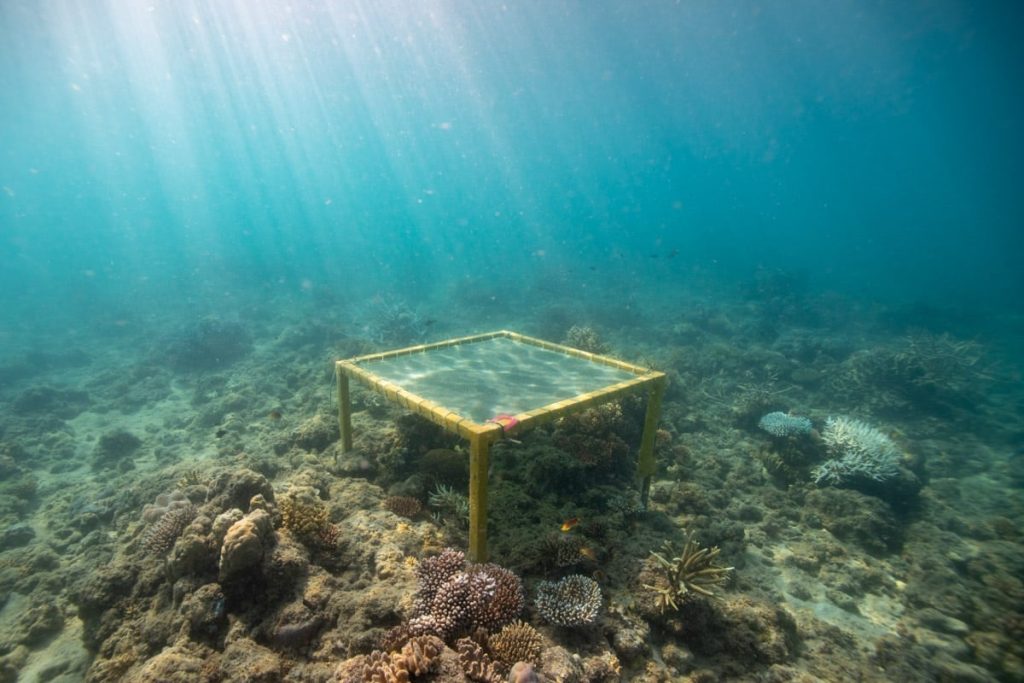Shading Corals Four Hours a Day Could Slow Bleaching, Scientists Find
4 min read
Shading corals on Lizard Island Research Station in the far northern Great Barrier Reef, in an earlier experiment initiated in the summer of 2020. Grace Frank / Australian Institute of Marine Science
Founded in 2005 as an Ohio-based environmental newspaper, EcoWatch is a digital platform dedicated to publishing quality, science-based content on environmental issues, causes, and solutions.
As the climate crisis causes global ocean temperatures to reach record highs, heat stress can lead to an increase in coral bleaching, which makes corals more susceptible to starvation and disease. Mass bleaching events are predicted to increase in severity and frequency, so scientists are trying to find solutions to protect sensitive corals.
In addition to curbing fossil fuel use in order to decrease emissions and mitigate global heating, there are steps humans can take to protect corals from extreme heat. Scientists have discovered that shading corals with fog or cloth can effectively protect them from excessive temperatures and stave off bleaching.
In a new study, a research team from Australia shaded two coral species to test their response and discovered that providing shade for four hours during the hottest part of the day can slow bleaching significantly.
“The health of coral reefs is declining from the effects of human activity and climate change,” the study said. “Mass coral bleaching is often triggered by elevated water temperature and excessive solar irradiance. Shading can reduce coral bleaching risk.”
The findings of the study could potentially help manage marine ecosystems, like the Great Barrier Reef, with regard to solar radiation.
“We show that intermittent shading under controlled conditions can moderate light stress and slow bleaching,” said Dr. Peter Butcherine, a Southern Cross University research fellow and lead author of the study, as Frontiers reported. “Reducing sunlight by 30% for four hours around solar noon can slow the onset of the bleaching response in some thermally-stressed shallow corals.”
The study, “Intermittent shading can moderate coral bleaching on shallow reefs,” was published in the journal Frontiers in Marine Science.
Coral reefs have deteriorated at unparalleled rates over the past 20 years, reported Frontiers. Extreme weather events have led to changes in the availability of nutrients in ocean water, as well as alterations in light and temperature that have contributed to widespread coral bleaching. In 2016 and 2017, 91 percent of the coral reefs in the Great Barrier Reef system experienced mass bleaching.
The research team collected two stony coral species — Turbinaria reniformis, or yellow scroll coral — and Duncanopsammia axifuga, or whisker coral. The team transported the coral samples to a lab where they placed them in tanks and covered them 30 percent with shade cloth for either 24 hours or for four hours around noon. Using the cloth to shade corals at midday for four hours results in light reductions similar to a cloudy day.
The results revealed that the shaded corals had significantly less bleaching than those that were unshaded, and those that had shade for 24 hours had the least amount of bleaching. More bleaching occurred in higher water temperatures as well.
The bleaching response of corals was delayed as many as three degree heating weeks (DHW) by shading them. Corals start to accrue DHW when water temperature gets more than one degree Celsius above the maximum average water temperature. Beyond this threshold, corals start to bleach. At four DHW of heat stress, significant coral bleaching occurs.
Shading didn’t have the same effect on the two types of corals. A delay in bleaching for T. reniformis was seen with four hours a day with 30 percent shading, while D. axifuga responded to around the clock shading up until three DHW, after which shading did not help the corals.
“The complex nature of coral interactions with their environment means there are likely to be a range of responses to shading. We showed that coral species can respond differently when shaded, but these differences were not necessarily detrimental, just different from each other,” Butcherine explained, as Frontiers reported.
Intense marine heat waves that last a long time create thermal stress that can override the benefits of shading, the researchers said.
“This work directly informs the development of cooling and shading interventions to help protect the Great Barrier Reef during future bleaching events,” said Dr. Daniel Harrison, a researcher and program lead of the Cooling and Shading subprogram of the Reef Restoration and Adaptation Program (RRAP) at Southern Cross University, as Frontiers reported. “Coral reefs are a critically important ecosystem so it is vital to investigate all the possible ways we can help them survive climate change.”
Seawater fogging systems is one of the methods to shade coral reefs that the RRAP Cooling and Shading program is working on.
“The focus of the fogging technologies we are developing is for deployment at an individual reef site of some tens of hectares in size,” Harrison said.
Currently, the team is working on the localized shading and cooling of small reef environments of high value.
“Our trials show some promising results, but there is still more research and development required before the current technologies are ready for scaled up deployment in the field,” Harrison added.
Subscribe to get exclusive updates in our daily newsletter!
By signing up, you agree to the Terms of Use and Privacy Policy & to receive electronic communications from EcoWatch Media Group, which may include marketing promotions, advertisements and sponsored content.





